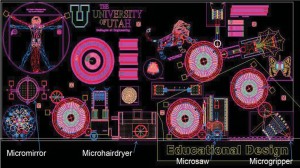Students from the University of Utah’s Department of Mechanical Engineering won this year’s Sandia microdevice competition for creating educational Micro Electro Mechanical Machines (MEMS) and functional microart that occupies two silicon chips, each approximately 2mm x 6mm. Students presented their efforts along with other winners at an awards program involving many Sandia MEMS engineers, which took place at Sandia National Laboratory in Albuquerque, New Mexico, on May 18, 2010.
Utah’s winning design, containing the work of Alumnus Brian Baker and Austin Welborn, featured a fully functional microbarbershop for styling one hair at a time. The chip also included Austin‘s micro-scale reproductions of works by Leonardo da Vinci including the “Vetruvian Man,” a mechanical lion, and his famous flapping wings.
“Our microbarbershop is so small that a single misty drop of an Irish drizzle would swamp the scissors and drown the device,” said Ian Harvey, a professor of mechanical engineering at the University of Utah and team advisor. “These devices demonstrate specific physical principles and consequences of dimensional downscaling to the micrometer level.”
The microbarbershop incudes a microgripper, microcutter, micromirror and microblow dryer – built to cut a single human hair. It is able to reach off the chip, grab a single hair and cut it using a microbuzzsaw
Team members worked hundreds of man-hours over the course of approximately three months to conceptualize, simulate and design their projects in AutoCad. This was the focal point of the spring semester course “Heterogeneous Microsystems Technologies.” The projects were then turned over to Sandia Labs where they were fabricated using their Sandia SUMMiT-VTM surface micromachining process.
After testing this fall, the chips will be used by Sandia National Laboratory as a set of combined outreach demonstrators for tour groups and interactions with grade K-12 students to stimulate interest in the visual “coolness,” of constructing and seeing machines at the micrometer scale and below to nanotechnology.
About the Sandia Microdevice Competition
The high-spirited contest, open to institutional members of the Sandia-led MEMS University Alliance program, provides an arena for the nation’s student engineers to hone their skills in designing and using microdevices. Such devices are used to probe biological cells, arrange and operate components of telecommunications and high-tech machinery and operate many home devices.
